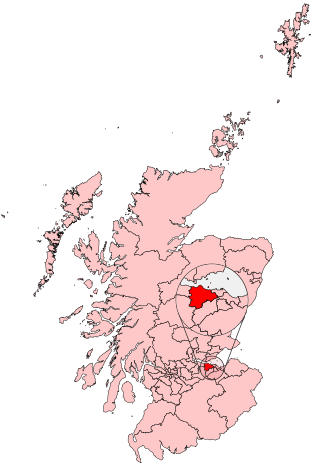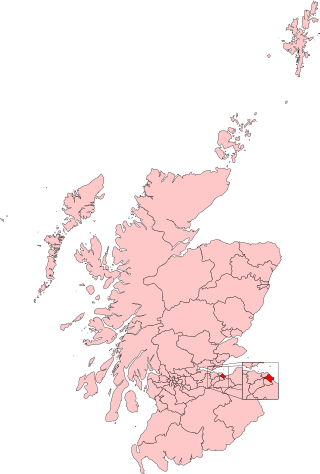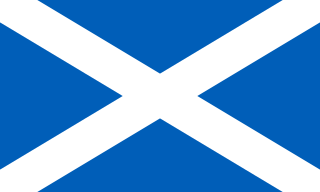
Lothian is a region of the Scottish Lowlands, lying between the southern shore of the Firth of Forth and the Lammermuir Hills and the Moorfoot Hills. The principal settlement is the Scottish capital, Edinburgh, while other significant towns include Livingston, Linlithgow, Bathgate, Queensferry, Dalkeith, Bonnyrigg, Penicuik, Musselburgh, Prestonpans, Tranent, North Berwick, Dunbar, Whitburn and Haddington.

Ettrick and Lauderdale was one of four local government districts in the Borders region of Scotland as well as a lieutenancy area from 1975 to 1996.

South of Scotland was one of the eight electoral regions of the Scottish Parliament when it was created in 1999. The region was replaced with South Scotland in 2011 following a review.

Edinburgh West is a burgh constituency of the House of Commons of the Parliament of the United Kingdom, first contested at the 1885 general election.

Edinburgh East was a burgh constituency of the House of Commons of the Parliament of the United Kingdom. It elected one Member of Parliament (MP) by the first past the post system of election.
Edinburgh Leith was a burgh constituency of the House of Commons of the Parliament of the United Kingdom from 1950 to 1997. It elected one Member of Parliament (MP) by the first past the post system of election.

Midlothian in Scotland is a county constituency of the House of Commons of the Parliament of the United Kingdom. It elects one Member of Parliament (MP) by the first-past-the-post voting system.

East Lothian is a constituency of the Scottish Parliament (Holyrood) covering most of the council area of East Lothian. It elects one Member of the Scottish Parliament (MSP) by the plurality method of election. It is also one of nine constituencies in the South Scotland electoral region, which elects seven additional members, in addition to the nine constituency MSPs, to produce a form of proportional representation for the region as a whole.
Edinburghshire was a Scottish county constituency of the House of Commons of the Parliament of Great Britain from 1708 to 1801 and of the Parliament of the United Kingdom from 1801 to 1918.

Scottish Westminster constituencies were Scottish constituencies of the House of Commons of the Parliament of Great Britain, normally at the Palace of Westminster, from 1708 to 1801, and have been constituencies of the House of Commons of the Parliament of the United Kingdom, also at Westminster, since 1801. Constituency boundaries have changed on various occasions, and are now subject to both periodical and ad hoc reviews of the Boundary Commission for Scotland.

Midlothian Council is the local authority for Midlothian, one of the 32 council areas of Scotland, covering an area immediately south of the city of Edinburgh. The council is based in Dalkeith. Since the last boundary changes in 2017, eighteen councillors have been elected from six wards.

Under the Representation of the People Act 1948 and the House of Commons Act 1949 new constituency boundaries were defined and first used in the 1950 general election of the House of Commons of the Parliament of the United Kingdom (Westminster).

The results of the First Periodical Review of the Boundary Commission for Scotland became effective for the 1955 general election of the House of Commons of the Parliament of the United Kingdom (Westminster). The review defined 32 burgh constituencies (BCs) and 39 county constituencies (CCs), with each electing one Member of Parliament (MP) by the first past the post system of election. Therefore, Scotland had 71 parliamentary seats.

Elections to Midlothian Council were held on 3 May 2007, the same day as the other Scottish local government elections and the Scottish Parliament general election. The election was the first one using six new wards created as a result of the Local Governance (Scotland) Act 2004. Each ward will elect three or four councillors using the single transferable vote system form of proportional representation. The new wards replace 18 single-member wards which used the plurality system of election.

Ettrick, Roxburgh and Berwickshire is a constituency of the Scottish Parliament (Holyrood) covering part of the council area of Scottish Borders. It elects one Member of the Scottish Parliament (MSP) by the plurality method of election. It is also one of nine constituencies in the South Scotland electoral region, which elects seven additional members, in addition to the nine constituency MSPs, to produce a form of proportional representation for the region as a whole.

Midlothian North and Musselburgh is a constituency of the Scottish Parliament (Holyrood) covering parts of the council areas of Midlothian and East Lothian. It elects one Member of the Scottish Parliament (MSP) by the plurality method of election. It is one of nine constituencies in the Lothian electoral region, which elects seven additional members, in addition to the nine constituency MSPs, to produce a form of proportional representation for the region as a whole.

The 2012 Midlothian Council election took place on 3 May 2012 to elect members of Midlothian Council. The election used the six wards created as a result of the Local Governance (Scotland) Act 2004, with each ward electing three or four Councillors using the single transferable vote system form of proportional representation, with 18 Councillors being elected.
The 1912 Midlothian by-election was a Parliamentary by-election held on 10 September 1912. The constituency returned one Member of Parliament (MP) to the House of Commons of the United Kingdom, elected by the first past the post voting system.

Elections to Midlothian County Council were held on 10 May 1961. Midlothian was one of the four divisions that made up the historic region of Lothian in Scotland. The Local Government (Scotland) Act 1889 established Midlothian as an administrative county, governed by a County Council.

Elections to Midlothian Council were held on 1 May 2003, the same day as the other Scottish local government elections and the Scottish Parliament general election. The election was the last one using the 18 single-member wards using the plurality system of election.

















